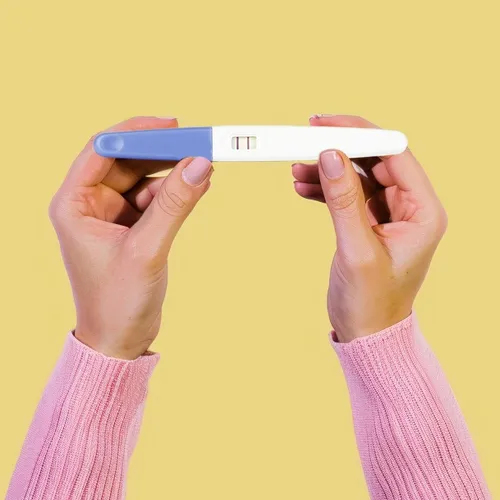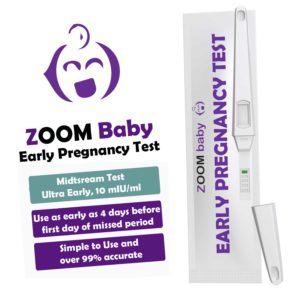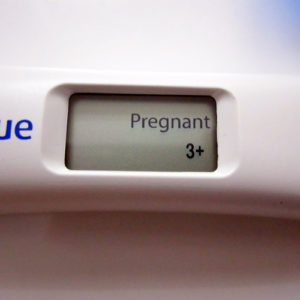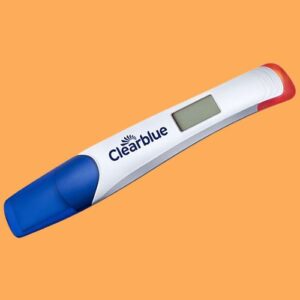Just because a pregnancy test is simple, that doesn’t mean it’s stress-free. The thing to remember when testing for pregnancy is that today’s pregnancy tests actually do work! We understand that when you’re waiting, full of uncertainty and anxiety, for those two magic lines to appear on a urine stick, it feels like time stands still – waiting with you to see what fate has in store. And then come the questions. What if the test was not accurate; what if the lines are so faint that the answer isn’t clear? Are pregnancy tests always 100% correct?
Let’s answer these questions, and more, and try to reduce the stress and anxiety that seems to go hand-in-hand with pregnancy testing. So, whether you think you may be pregnant, or you’re trying to get pregnant, let’s discuss how pregnancy tests work, which one to buy, what time during your cycle the test should be taken, the best time of the day to take a pregnancy test, and what to do if your pregnancy test should prove negative.
Over-The-Counter Pregnancy Tests: How They Work
There are a number of different over-the-counter (OTC) pregnancy tests available for purchase: some have a plus or minus sign, some have double lines (either pink or blue), some have “pregnant” or “not pregnant”, and some have words like “yes” or “no”. OTC pregnancy tests range in price; however, they all work by detecting a placenta-produced hormone known as Human Chorionic Gonadotropin, commonly known as hCG. Once an embryo has implanted in the uterus, hCG can be detected in your urine and bloodstream almost immediately.
Once you’ve taken your pregnancy test (peed on the stick) and waited the prescribed amount of time, you will see either a positive or negative result, depending on the presence, or lack of, hCG. If you’ve chosen to use a traditional, or non-digital, OTC pregnancy test, you’ll know immediately if implantation has occurred when you can see two lines – that would be a BFP (big fat positive!). On the other hand, if there’s only one line then you have a negative result. Of course you can always take another test if you want to be sure.
There are certain benefits in using a digital pregnancy test. The technology of digital pregnancy test kits means that they are now able to spot a pregnancy before you’ve missed your period. This is because digital tests can detect hCG levels that are really low, like around the 15 mIU/mL mark, whereas with non-digital OTC pregnancy tests the hCG level has to be around 40 mIU/mL to enable detection. Also, with digital tests you’re more likely to see the words “pregnant” or “not pregnant”, which can be very reassuring.
How Do I Know Which Pregnancy Test to Purchase?
When it comes to over-the-counter pregnancy tests you’ll find that they come in a wide range of prices. First you need to decide which method would work best for you, because even though the tests work in the same way, some have different methods for testing. With some tests you need to pop the testing stick into a cup of urine, while with others you’re required to hold the stick under your urine stream. So make sure you read the instructions before purchasing so you know which method to use. If you’re in a hurry, the testing strip you use while you pee would probably be the quickest and easiest.
Keep in mind, also, that the lines on non-digital pregnancy tests can be either pink or blue; either way, if you can see both lines, then you’re pregnant. Many women prefer pregnancy tests with blue lines, as they seem to be easier to read than pink lines. If the lines are showing up after taking a test, but they’re not very clear, then take another test in a day or two.
As mentioned above, pregnancy tests can range in price from a box of two tests from a pound shop right up to £12 for a brand-name pregnancy test. They can also be purchased in bulk from online retailers. So the question is: can we trust cheap pregnancy tests or is it a case of ‘you get what you pay for‘? The answer is that, if you have purchased an FDA-approved test, the results are more than 90% accurate. Certainly, different pregnancy tests will detect slightly different hCG levels in your urine, but as long as you follow the instructions and take the pregnancy test at the right time, it’s really not necessary to pay £12 for the test. This means that the most expensive pregnancy testing kits at your local pharmacy may not be any more effective than cheaper brands.
If you want to take your pregnancy testing to the next level, you may be interested in a recent innovation whereby your pregnancy test will not only tell you that you’re pregnant, it will also tell you how far along you are. Digital pregnancy tests by Clearblue report a 99% accuracy as to whether you’re pregnant, or not, and an accuracy rate of between 45% and 99% when estimating the number of weeks since ovulation. This pregnancy testing technology by Clearblue is still quite new, but it does show that technology is evolving. If you really want to confirm how far along your pregnancy is then simply make an appointment to visit your health practitioner.
Getting It Right the First Time
If you’re trying to get pregnant you may have come across the acronym 2WW – this stands for “two-week wait“. 2WW is the time between ovulation and the best time to use a pregnancy test. Providing your periods are regular, this would be approximately a day after your period would have arrived. Timing is the best way to make sure your pregnancy test is as accurate as possible, and you could well receive a false negative result if you take the test too early.
Remember that the instructions that come with your pregnancy testing kit are there for a reason, so make sure you follow the instructions very carefully. For example, don’t pee over the entire stick if the instructions say to submerge the stick up to a certain point. If the instructions say to wait five minutes before checking the results, then set a timer for five minutes. Reading the results too early could give you a false negative result, and if you wait too long the results may fade. Incidentally, if you do get a false negative result, commonly known as a BFN (big fat negative), then simply take another pregnancy test to confirm the result. False negative results can occur if you take the test too early, check your test results too soon, or use diluted urine. For this reason, it is strongly recommended that you take a pregnancy test when your urine is the most concentrated, typically first thing in the morning.
What’s the Best Time of the Day to Use a Pregnancy Test Kit?
To achieve a high level of accuracy with your pregnancy test, you should take the test when you first empty your bladder in the morning. Your urine becomes diluted throughout the day as you consume liquids, so if you take the test sometime throughout the day, you’re increasing the chances of getting a false negative, meaning that the test may not be able to detect the proper level of hCG.
What Do I Do If I Get a Negative Result?
Try not to panic or get too upset if your pregnancy test reveals a BFN. Keep in mind that, after six months of trying to get pregnant, almost 20% of couples are unable to conceive. There are so many factors that come into play when you’re trying to conceive. For example, perhaps you misjudged your ovulation date, or maybe you’ve been going through a very stressful time at work. Have you been exercising excessively?
Why not be proactive about your desire to become pregnant and make an appointment to visit your local health practitioner and let him/her know that you’re trying to get pregnant? Your doctor will be able to take a close look at your lifestyle and determine what may be hindering your success.
It could even be that the personal lubricant you’re using is not ideal for a woman trying to get pregnant! Did you know that many of the commercially available personal lubricants on the market today actually hinder sperm motility? One personal lubricant, known as Conceive Plus is compatible with sperm and oocytes and has been especially designed for couples who are trying to get pregnant. If you’re not using a sperm-friendly lubricant at the moment, why not get some Conceive Plus from Zoom Baby. This one simple change could very well be all that’s needed to give you that big fat positive you’re hoping for. Good luck!
When to Contact Your Doctor
If you have been trying to conceive for over a year (or 6 months if you are over 35) without success, it may be time to consult with your doctor. There could be underlying fertility issues that need to be addressed. Your doctor can run tests to check hormone levels, assess ovulation, and examine your reproductive organs. They may recommend lifestyle changes, medications, or procedures to improve your chances of conceiving.
Additionally, if you have irregular periods, painful periods, a history of pelvic inflammatory disease, or endometriosis, speak with your doctor sooner rather than later. These conditions can impact fertility. The earlier any issues are identified and treated, the better your odds of a successful pregnancy. Remember, you are not alone on this journey. Your healthcare provider is there to support you every step of the way.
Photo credit; “The Best Way to Take a Pregnancy Test” by Anthony Cunningham for Zoom Baby
Zoom Baby is a leading supplier of Pregnancy Tests and Ovulation Test Kits






